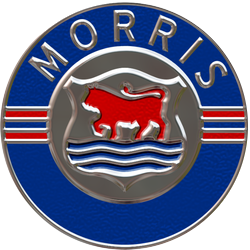
Land Rover is a British brand of predominantly four-wheel drive, off-road capable vehicles, owned by multinational car manufacturer Jaguar Land Rover (JLR), since 2008 a subsidiary of India's Tata Motors. JLR currently builds Land Rovers in Brazil, China, India, Slovakia, and the United Kingdom. The Land Rover name was created in 1948 by the Rover Company for a utilitarian 4WD off-road vehicle; currently, the Land Rover range consists solely of upmarket and luxury sport utility vehicles.

The Mini is a small, two-door, four-seat car, developed as ADO15, and produced by the British Motor Corporation (BMC) and its successors, from 1959 until 2000. Minus a brief hiatus, original Minis were built for four decades and sold during five, from the last year of the 1950s into the last year of the 20th century, over a single generation, as fastbacks, estates, and convertibles.

Morris Motors Limited was a British privately owned motor vehicle manufacturing company formed in 1919 to take over the assets of William Morris's WRM Motors Limited and continue production of the same vehicles. By 1926 its production represented 42 per cent of British car manufacture—a remarkable expansion rate attributed to William Morris's practice of buying in major as well as minor components and assembling them in his own factory. Self-financing through his enormous profits Morris did borrow some money from the public in 1926 and later shared some of Morris Motors' ownership with the public in 1936 when the new capital was used by Morris Motors to buy many of his other privately held businesses.

Sir Alexander Arnold Constantine Issigonis was a British-Greek automotive designer. He designed the Mini, launched by the British Motor Corporation in 1959, and voted the second most influential car of the 20th century in 1999.
The automotive industry in the United Kingdom is now best known for premium and sports car marques including Aston Martin, Bentley, Caterham Cars, Daimler, Jaguar, Lagonda, Land Rover, Lister Cars, Lotus, McLaren, Mini, MOKE, Morgan and Rolls-Royce. Volume car manufacturers with a major presence in the UK include Nissan, Toyota, BMW, and Vauxhall Motors. Commercial vehicle manufacturers active in the UK include Alexander Dennis, Dennis Eagle, IBC Vehicles, Leyland Trucks, TEVVA and London Electric Vehicle Company.

The Austin Motor Company Limited was an English manufacturer of motor vehicles, founded in 1905 by Herbert Austin in Longbridge. In 1952 it was merged with Morris Motors Limited in the new holding company British Motor Corporation (BMC) Limited, keeping its separate identity. The marque Austin was used until 1987 by BMC's successors British Leyland and Rover Group. The trademark is currently owned by the Chinese firm SAIC Motor, after being transferred from bankrupt subsidiary Nanjing Automotive which had acquired it with MG Rover Group in July 2005.

British Leyland was an automotive engineering and manufacturing conglomerate formed in the United Kingdom in 1968 as British Leyland Motor Corporation Ltd (BLMC), following the merger of Leyland Motors and British Motor Holdings. It was partly nationalised in 1975, when the UK government created a holding company called British Leyland, later renamed BL in 1978. It incorporated much of the British-owned motor vehicle industry, which in 1968 had a 40% share of the UK car market, with its history going back to 1895. Despite containing profitable marques such as Jaguar, Rover, and Land Rover, as well as the best-selling Mini, BLMC had a troubled history, leading to its eventual collapse in 1975 and subsequent part-nationalisation.

The Morris Minor is an economy car produced by British marque Morris Motors between 1948 and 1971. It made its debut at the Earls Court Motor Show, London, in October 1948. Designed under the leadership of Alec Issigonis, more than 1.6 million were manufactured in three series: the Series MM, the Series II, and the 1000 series.

The Mini Moke is a small, front-wheel-drive utility and recreational convertible, conceived and manufactured as a lightweight military vehicle by British Motor Corporation (BMC), and subsequently marketed for civilian use under the Austin, Morris, Leyland, and Moke brands. The name "Mini Moke" combines mini with moke, an archaic term for a mule. The Moke is known for its simple, straightforward, doorless design; and for its adaptability.

The Austin Champ was a military and civilian jeep-like vehicle made by the Austin Motor Company in the 1950s. The army version was officially known as "Truck, 1/4 ton, CT, 4×4, Cargo & FFW, Austin Mk.1" however the civilian name "Champ" was universally, if unofficially, applied to it. The majority of Champs produced went to the British Army.

A transverse engine is an engine mounted in a vehicle so that the engine's crankshaft axis is perpendicular to the direction of travel. Many modern front-wheel drive vehicles use this engine mounting configuration. Most rear-wheel drive vehicles use a longitudinal engine configuration, where the engine's crankshaft axis is parallel with the direction of travel, except for some rear-mid engine vehicles, which use a transverse engine and transaxle mounted in the rear instead of the front. Despite typically being used in light vehicles, it is not restricted to such designs and has also been used on armoured fighting vehicles to save interior space.

The BMC E-series engine is a line of straight-4 and straight-6 overhead camshaft automobile petrol engines from the British Motor Corporation (BMC). It displaced 1.5 L or 1.8 L in four-cylinder form, and 2.2 L or 2.6 L as a six-cylinder. The company's native United Kingdom market did not use the 2.6 L version, which was used in vehicles of Australian and South African manufacture. Although designed when the parent company was BMC, by the time the engine was launched the company had become British Leyland (BL), and so the engine is commonly referred to as the British Leyland E-series engine.

The Mark I Mini (1959–1967) was the first version of British Motor Corporation's Mini model. It is characterised by its sliding windows, external door hinges and "moustache" grille. In the United Kingdom the Mark I was produced between 1959 and 1967 at the Longbridge Plant near BMC's headquarters, with production in Australia continuing until 1970. The Mini Mark I was sold under both Austin and Morris marque names.

Mini is a British automotive brand founded in 1969, owned by German automotive company BMW since 2000, and used by them for a range of small cars assembled in the United Kingdom, Austria and the Netherlands. The word Mini has been used in car model names since 1959, and in 1969 it became a brand in its own right when the name "Mini" replaced the separate "Austin Mini" and "Morris Mini" car model names. BMW acquired the brand in 1994 when it bought Rover Group, which owned Mini, among other brands.

The Range Rover is a 4x4, mid-size off-road vehicle series produced from 1970 to 1996 – initially by the Rover division of British Leyland, and latterly by the Rover Group.
The Nuffield Guppy was a small military vehicle designed by Sir Alec Issigonis while he worked for the Nuffield Organization in the early 1940s. The vehicle was designed to be parachute-droppable and was intended to assist paratroops to transport loads up to 500 lb (227 kg) at walking speeds and to be amphibious. The vehicle resembled the DUKW but was only about 8 feet (2.4 m) long. It had large balloon tyres and an outboard motor at the rear. It was capable of carrying one person with equipment, or being used as a motorised wheelbarrow by someone walking alongside the vehicle.

The Land Rover Series I, II, and III, or simply the Land-Rover are compact British off-road vehicles, produced by the Rover Company since 1948, and later by British Leyland. Though inspired by the World War II jeep, the Land Rover immediately distinguished itself from all other cars. From launch, it was the first mass-produced civilian four-wheel drive car with doors, and an available hard roof. Contrary to conventional car and truck chassis, it used a sturdier fully box-welded frame. Furthermore, due to post-war steel shortage, and aluminium surplus, Land Rovers received non-rusting aluminium alloy bodies, favouring their longevity. In 1992, Land Rover claimed that 70% of all the vehicles they had built were still in use.
British Motor Corporation (Australia) was a motor manufacturing company formed in Australia in 1954 by the merger of the Austin Motor Company (Australia) and Nuffield (Australia). This followed the merger in 1952 of the Austin Motor Company and the Nuffield Group in the United Kingdom to form the British Motor Corporation. Following further corporate changes in the UK in the late 1960s, BMC Australia was absorbed into the newly established British Leyland Motor Corporation of Australia, the name of which became Leyland Motor Corporation of Australia in 1972, and then JRA Limited in March 1983.
There have been a number of Mini concept cars, produced to show future ideas and forthcoming models at international motorshows.

The MOKE is a recreational vehicle manufactured by Chery Automobile in China since 2013 and assembled by a variety of companies in the United States, United Kingdom, France, and others. The design, by British industrial designer Michael Young, evokes the classic Mini Moke built from 1964 until 1993. The name "Mini Moke" combines Mini with Moke, an archaic term for mule. The new version is simply called "MOKE".
















